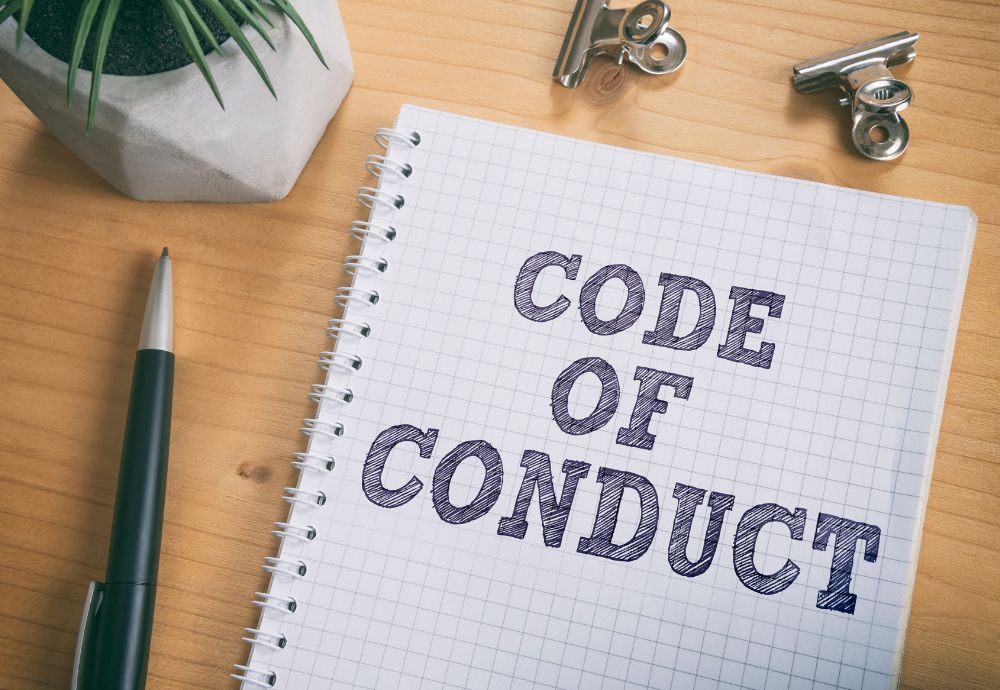First published on Thursday, Jun 04, 2020
Last updated on Friday, Oct 27, 2023
Managing a workplace comes with many challenges.
Among the most complex circumstances any manager or supervisor may need to face, is dealing with poor workplace conduct.
This can include anything from unexplained absences and persistent lateness to a resistance to change behaviours that have an immediate effect on other employees like bullying, harassment, and aggression.
The latter will also tie into the health and safety of your team members in the workplace.
That's why we're taking you through all the aspects you need to think about when it comes to your workplace code of conduct.
From company policies to what behaviours you can expect your employees to maintain, and the disciplinary action you can take if an employee refuses to comply with guidelines.
What is employee conduct?
Employee conduct refers to the way your team members behave in particular circumstances. And the way an individual is expected to behave will change in different situations.
For example, you will very likely expect employees to behave differently in the workplace than they would on vacation with their friends. There will also likely be a different code of conduct your employees will be expected to follow if they work at the office as opposed to if they're putting in their hours at home.
We'll explore the details of what your code of conduct will include in a while. But first...
Why is employee conduct important?
You may wonder why you need to have a code of conduct in your workplace in the first place. Especially if you are a small business.
Does a work environment require you to outline appropriate behaviour in the form of a workplace policy or employee handbook? Won't employees already understand what appropriate behaviour is required in a work environment? Does behaviour matter to ensure an employee's employment if their output remains consistent?
Productivity and outcomes are measurable outputs of any workplace, but the code of conduct your employees follow is a key part of any successful business.
Managing employee conduct is a major factor in the smooth running of your business. You need to be able to manage staff and take disciplinary action against team members who do not comply with the code of conduct you have set in place.
If you have employees who are a constant disruption, this could have a negative effect on other employees. By setting out a clear employee code of conduct, it makes it easier to discipline them and take the appropriate action.

What are the consequences of letting inappropriate behaviour go unaddressed?
The way your employees conduct themselves is a key part of running a successful business. The effects of misbehaviours at work shouldn’t be ignored.
As the employer or owner of a business, you hold legal responsibilities for workplace actions and will need to deal with the possible consequences of poor employee conduct.
Failure to manage employee conduct correctly can lead to:
- A decrease in staff morale
- A drop in productivity
- Higher employee turnover
- More psychosocial hazards
- Toxic workplace culture
- Poor health and safety
- Workplace claims including sexual harassment claims
- Serious misconduct
- Legal action taken against you as an employer
What is an employee code of conduct?
An employee code of conduct isn't just general guidelines your human resources team shares that are understood amongst team members.
A code of conduct is a company policy shared with all employees that sets out your expectations for what behaviour is acceptable in the workplace. It is an official company document and it should be treated as such.
Make sure your employee code of conduct is shared at the outset of your employee's employment with you, alongside documents like their employment contract and employee handbook.
Visibility is key to making sure your employees understand and are consistently reminded of the code of conduct they need to live up to.
What should you include in your employee code of conduct?
To make sure your code of conduct is effective for your staff, you need to include reasonable directions for all the relevant circumstances your employees may find themselves in.
This means that from business to business your code of conduct will vary depending on your needs.
Your code of conduct could include:
- Dress code
- Your policies surrounding leave
- How to report any workplace misconduct
- Grievance procedures
- Disciplinary actions
- Break entitlements
- Use of social media, technology, and company property
- Illegal activities such as corruption, fraud, and plagiarism

The importance of having a code of conduct in your workplace policy
There are a multitude of reasons why having a code of conduct is important.
Some of the key reasons are:
- It provides guidelines on acceptable employee behaviour and sets a clear standard of what’s expected.
- It illustrates your company’s ethics and values. A code of conduct establishes how potential clients, customers, and employees can expect to be treated.
- It sets the tone for your workplace culture. A code of conduct can inform, but also place responsibility on your company employees to uphold these behaviours.
- It boosts employee morale and productivity as well as reduces employee turnover because they understand the value of treating each other with respect.
- It sets a standard for ethical behaviour and the treatment of sensitive information.
- It shows your employees that while standards of performance are important, good workplace conduct that promotes a culture of respect is valued by you.
- It provides a clear structure for dealing with problems that your managers can follow.
- It can standardise procedures to help you make sure everyone is treated fairly and equally in similar circumstances
Reducing the need for external intervention
Another key goal your code of conduct will aim to achieve is to resolve conflicts and issues swiftly and internally.
When poor behaviour occurs freely and openly in the workplace it's a slippery slope to a toxic workplace environment that goes against the best interest of your team. This can, in turn, lead to more workplace claims that can be costly and time-consuming to resolve.
Having a company policy in place to deal with poor workplace conduct supports you in the event that a conflict does occur.
It can also help you prove that the procedure you’ve followed complies with the law.
Is employee conduct outside the workplace important?
If your answer to that question is an immediate no, then we have news for you.
Employee conduct outside the office is also important when your employee is representing your company.
Although you can’t expect employees to behave the same outside of the office, their behaviour outside the workplace may still reflect negatively on you.
Before you take disciplinary action in the event that your employees' behaviour outside the workplace has reflected poorly on your organisation, you need to assess the impact of their behaviour before deciding to discipline them.
If the employee's actions have consequences on their colleagues or customers, it could affect workplace morale and create conflict. So, it's important that your code of conduct outlines expectations for every possible event and disciplinary action when needed.
Speaking of which...
Managing disciplinaries
Every workplace will encounter disciplinary issues at some point. Some issues that are bound to arise as your team grows are:
- Clashes due to differences in personality and work styles, which are the root of many workplace conflicts
- A lack of respect between your employees that can result in a whole host of issues including bullying, refusal to collaborate, and discrimination
- Organisational or team changes that lead to drops in motivation and productivity
It's important that you're aware of the many ways issues can arise in your workplace and how they may affect conduct.
You may not be able to eliminate disciplinary issues, but the aim should always be to avoid them as far as possible and arrest minor issues before they escalate.

Disciplinary procedures
To stay ahead of these issues at work, your disciplinary procedure will likely need to tackle two areas: general conduct and employee performance.
The former refers to those issues that can affect your day-to-day operations, like:
- Lateness
- Refusal to cooperate within a team
- Misuse of IT and company property
- Bullying and discrimination
Employee performance issues, on the other hand, will affect your staff's career trajectory. It's important to differentiate between the two because one may not necessarily affect the other, but they can both have distinct effects that you need to address.
How should I take disciplinary action over employee conduct?
You should clearly set out the disciplinary actions surrounding employee conduct in the workplace.
The action you take will vary depending on the circumstances, and you need to make sure you're following laws and industry rules at all times.
A verbal warning
This is generally the first step when it comes to dealing with any workplace issue from employee conduct to job performance. That is as long as the incident doesn't involve serious misconduct.
A verbal warning involves your human resources team or a manager speaking to the employee one-on-one about their conduct at work.
A written warning
This could be the next step following a verbal warning.
Issuing a conduct letter is a formal way to send a written warning and it should include the behaviour in question, your concerns, and the next steps.
Performance review
An appropriate setting to bring up an employee’s poor conduct in the workplace could be during their performance review.
This one-to-one meeting is a great opportunity to try and get to the root of the problem.
Following this meeting, many businesses will follow up with a performance improvement plan to ensure better conduct moving forward.
Employee termination
If all of the above fails to solve the problem, you may have to terminate their employment with your organisation.
This should be your last resort. It should also always be carried out in line with the laws and the rules of the relevant award. In some circumstances of poor conduct issues, however, this outcome may be unavoidable.
Implementing your code of conduct in the workplace
Like it is with any workplace change you try to make, simply creating an exhaustive document is never enough.
That's why implementing the code of conduct you write is just as critical as effectively communicating it to your staff. That includes your managers who will need to lead and reinforce this conduct by example.
There are many ways to keep your team members aware of your code of conduct, and you should be mindful of picking the most effective way to do so for your business. And make sure that you're making the most of every channel available to you.

Your awareness pathway can look something like this:t
- Induction and onboarding: Sharing your code of conduct at the onboarding and induction of new employees helps them start off on the right foot and understand your expectations
- One-on-one training: This can be a conduct reminder delivered by employers, business owners, managers, or HR members to current employees
- Employee handbook: This document is one that's freely available to all employees, making it a great outlet to include your code of conduct
- Company intranet: Placing your code of conduct centrally ensures that your staff can access it at any time, whether they're working remotely or at your work premises
- Online training: Refresh your employees' understanding of your code of conduct or update them on any changes with regular training. A gamified training platform can also improve engagement and pick-up of your policies
- Company-wide noticeboard: Visibility is key. If your staff works in-office or hybrid, placing these around the workplace will help keep your staff updated
Get proactive support with your employee conduct today
Having a code of conduct, setting disciplinary actions for noncompliance, and implementing this code are all critical steps. But that doesn't mean your workplace will operate without a hitch.
That's why getting the right tools in your arsenal can make all the difference, and help you get ahead of potential issues.
How can BrightHR help? Get easy-to-use document templates
We make it easy to meet your documentation requirements with a library of easy-to-use document templates that you can browse, download, and use.
That includes documents like policies, contracts, handbooks, and factsheets that have saved our customers over 5,000 hours they would have otherwise spent on HR admin over the course of the year.
Receive 24/7 employment relations advice
There are some employee issues and HR hurdles that you just need a second opinion on to make sure you're doing the right thing.
That's why our experienced team of employment relations advisers are available on hand to offer you prompt advice and confidential support whenever you need it. So, you and your business are covered no matter what employee conduct issues come your way.
